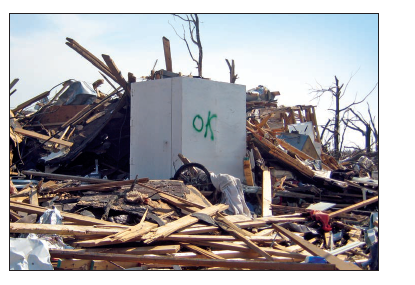Every year, tornadoes, hurricanes, and other extreme windstorms cause numerous injuries and deaths in the United States. While we cannot stop these storms from occurring, we can respond by understanding the hazards and carefully planning to protect ourselves from their effects. FEMA and its partners help protect people from severe wind events through promoting safe rooms. FEMA provides guidance and best practices on safe room design and construction, participates in safe room-related standard and building code development, provides funding for safe rooms and monitors a safe room helpline to answer safe room-related technical questions.
Summary of FEMA’s Safe Room Activities
Providing guidance and best practices on safe room design and construction
FEMA produces technical publications, fact sheets, and training materials for engineers, architects, building officials, and prospective safe room owners on the design, construction, operations, and maintenance of safe rooms (https://www.fema.gov/emergency-managers/risk-management/safe-rooms/resources). A safe room is a storm shelter specifically designed to meet FEMA Funding Criteria and provide near-absolute protection in extreme wind events, including tornadoes and hurricanes. To be considered a safe room, the structure must be designed and constructed to the guidelines specified in FEMA P-361, Safe Rooms for Tornadoes and Hurricanes: Guidance for Community and Residential Safe Rooms. A safe room can be constructed or installed on a property to serve a residence or within the community to serve a larger number of people.
Participating in safe room-related standard and building code development
FEMA works with its partners in resiliency, the International Code Council® (ICC®) and National Storm Shelter Association (NSSA®) to improve the storm shelter standard, Standard for the Design and Construction of Storm Shelters (ICC 500). FEMA also recommends building code updates to improve construction of and access to storm shelters and safe rooms for vulnerable populations.
Providing funds for safe rooms
The federal government makes funds available to construct residential and community safe rooms. FEMA provides hazard mitigation funding to eligible states, tribes and territories that provide funding to local governments to assist in reducing overall risk to people and property. FEMA’s grant programs to fund eligible safe room projects include the Hazard Mitigation Grant Program (HMGP) and Building Resilient Infrastructure and Communities (BRIC)program. Funding may also be available from other sources such as the U.S. Department of Housing and Urban Development’s Community Development Block Grant Funds and Federal Housing Administration Mortgage-Insured Financing. You can find more information about various funding opportunities on the Safe Room Funding webpage.
Assessing damage caused by extreme wind events
After severe tornadoes, large tornado outbreaks, or hurricanes, FEMA may send a Mitigation Assessment Team (MAT) to assess the performance of affected buildings and develop recommendations for reducing injuries and loss of life following future events. Recommendations and findings have helped inform FEMA safe room guidance over the years. MATs are composed of subject matter experts and professionals from government agencies and private firms, including structural engineers, wind engineers, architects, building code officials and emergency planners. More information, as well as publications, can be found on the Mitigation Assessment Team webpage.
Answering questions from the public, industry, and government
FEMA hosts the Safe Room Helpline, responding to inquiries concerning FEMA’s safe room publications and guidance. Inquiries can be sent to Saferoom@fema.dhs.gov or made by calling 866-927-2104.

An above-ground residential safe room that was in the garage of a home hit by an EF5 tornado in Joplin, Missouri (2011). This saferoom was built to meet FEMA guidance, which offers near-absolute life-safety protection, so the occupants were unharmed even though their house was destroyed.

